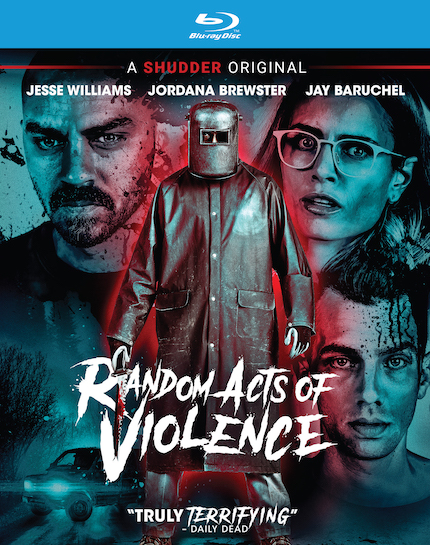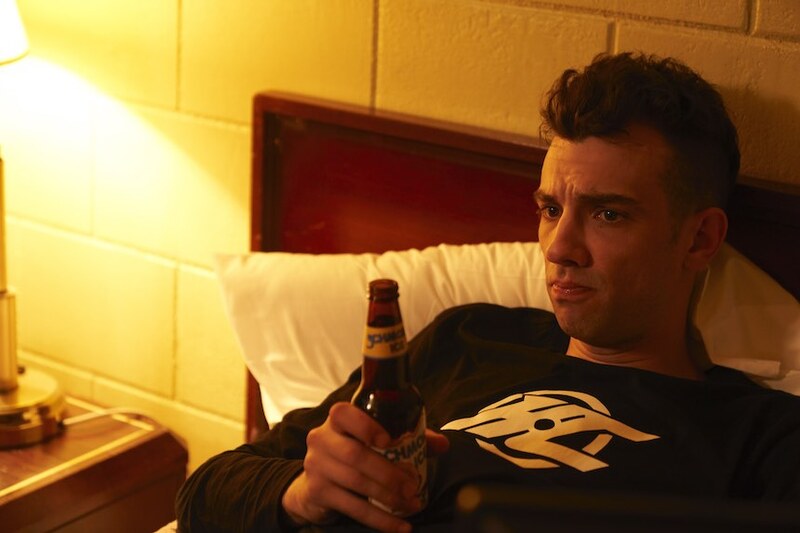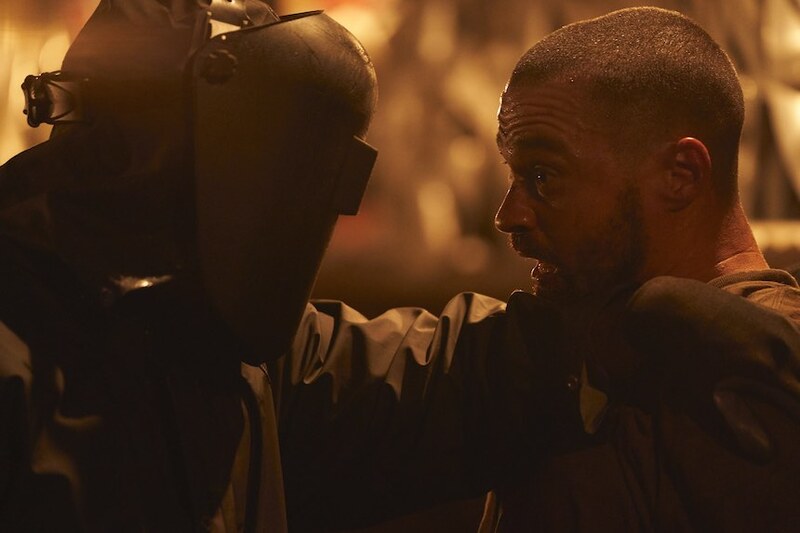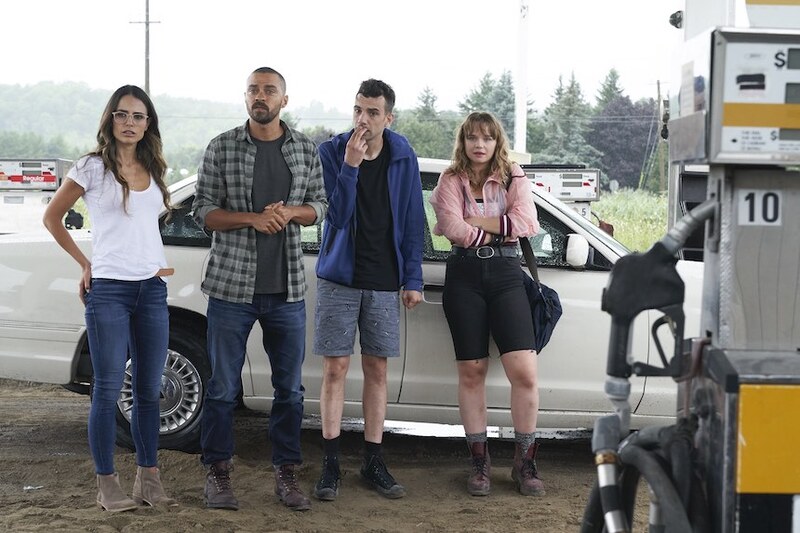RANDOM ACTS OF VIOLENCE Interview: Jay Baruchel On His Potent Horror Debut

Canada’s Jay Baruchel became known as part of the group of young comedians linked to Judd Apatow. In the romantic comedy Knocked Up, for example, he portrayed one of the friends of the protagonist played by Seth Rogen. He later had a similar role in the apocalyptic comedy This Is the End, where this group of actors took self-reference and self-parody to another level.
Like Rogen and Jonah Hill, Baruchel became a director: he debuted with Goon: Last of the Enforcers, sequel to Goon, which was co-written by Baruchel. This pair of films – in which Baruchel plays the friend of the main character (Seann William Scott) – combine sport (ice hockey) with comedy, romance and violence, the latter because they are focused on an enforcer: a player who only enters the rink to fight.
Baruchel took an important turn in his second feature film as director: Random Acts of Violence is a horror movie connected to the slasher subgenre. Following the original graphic novel – written by Jimmy Palmiotti and Justin Gray, published in 2010 – Baruchel explores the relationship between real and fictional violence.
Jesse Williams plays Todd, creator of the highly successful and violent comic book Slasherman, which is inspired by a real serial killer who terrorized – from 1987 to 1991 – an area of the I-90.
While writing the grand finale of Slasherman, Todd takes a road trip to get inspired in the area where the killer took the lives of six people and disappeared without a trace. Todd is accompanied by his editor Ezra (Baruchel himself), his assistant Aurora (Niamh Wilson), and his girlfriend Kathy (Jordana Brewster), who is conducting her own research with the goal of publishing a book on the victims to counter the growing mythology of the victimizer.
A work like Slasherman is not for everyone; there are those who call it immoral. But not even the worst critics compare to the nightmare that Todd will live with the return of the real Slasherman, now inspired by the comic book. Who will be the next victims? Besides the comic, does anything else connect Todd to the killer?
On the occasion of the release of Random Acts of Violence on Blu-ray, DVD, VOD and Digital, I chatted with Baruchel about the controversial subject of violence, the connection between reality and fiction, as well as his cinematic influences and the collaboration with Rogen and company.
ScreenAnarchy: RANDOM ACTS OF VIOLENCE is your second film as director. Although GOON is about hockey, it also tackles violence. What draws you to this subject?
Jay Baruchel: If I was gonna get super analytical about it, I think it comes down to a few things, like my dad. He loved getting into fights, hockey fighters and action movies. Me as a kid, for whatever reason, I was always drawn to The Punisher, that was one of my favorite superheroes when I was a kid.
To be honest, I think it’s because violence should cut through the brain and go straight to the heart. Horror and action movies are to cinema what heavy metal, punk and industrial are to music. You lean into something real that you don’t have words for. There’s a purity and a simplicity to that stuff too, there’s something incredibly honest about it. And this entire thing, they call it civilization, is informed by and a reaction to violence. Each one of us comes into the world through a violent act.
It’s just something that’s very vividly my whole life. I’ve spent a bunch of my adult life trying to unpack why, like, I’m not a particularly violent person, I just also know the colors that I’m interested in and what I would like to paint with. If I ever get to direct again, I’ll never make a movie where someone doesn’t at least get their ass kicked in it.
Even though the graphic novel is from 2010, people fearing that fiction might provoke real-life violence feels more relevant today. There’s the controversy surrounding JOKER, for example.
When I was a kid in high school is when Columbine happened and the dialog about the Columbine massacre was pretty simplistic and facile. It was first people saying, well these kids did it ‘cause of Doom and Marilyn Manson, which is provable horseshit, didn’t have any basis in reality. But I think the sort of knee-jerk response to that was: oh, therefore I can do and say anything and I have no responsibility for putting it out into the world, which I think is equally horseshit. Like if I go out and say something to a complete stranger, I am to some degree responsible for whatever might happen. To pretend that because I wrote a song or wrote a movie and it’s out there that I don’t own any of that, I think that that’s horseshit.
I’m interested in a sort of cycle that we are born into and contribute to, trying to determine a clear kind of chicken-and-egg moment where this causes that is an impossibility, because this shit was fucked long before any of us showed up, the world’s been a violent place for a very long time. What I find fascinating is how we all are informed by that, how it pushes us in different directions, and how an act of therapy for the sake of therapy, when packed as this art, has some ramifications.
RANDOM ACTS OF VIOLENCE is a potent slasher: gruesome, crazy and, of course, violent. How was your approach to the most explicit sequences?
We were very, very specific and mindful in our violence. We were trying to achieve verisimilitude, we wanted it to be unpleasant, we wanted to counteract 40, 50 years of outlandish body horror, kind of like arterial spray shit. When a body does something in a movie that it can’t actually do, when someone’s head gets chopped right off and there’s a fountain of blood coming out of the fucking hole and the throat, it’s many things: it’s shocking, it’s entertaining, you can gloat over the artristy of the prosthetic work, but it’s not fucking scary. Nothing about that is scary because it’s so fucking unrealistic you can’t possibly see yourself in it.
So number one, it’s just not scary, number two we wanted to make people ask themselves: what is my experience as a moviegoer when I watch a movie with Jason, Michael Myers or Freddy just eviscerating a movie’s worth of kids? Can I honestly say any of those kids are the protagonists? Well, maybe, but if I can’t fucking name any of them, then probably not. But I can name Jason, Freddy and Michael Myers, so if I can name them and can’t name the kids, the killer or the monster is a more defining character than the kid is, then what is that experience when I watch it? Well, it’s nothing short of vicarious sadism, I would argue. And it’s not for me to say good or bad, I’m just saying it was something that I noticed in myself that I wasn’t comfortable with.
Something else I noticed in myself that I wasn’t confortable with is just as I could name Jason or Freddy but none of the kids they killed, I could name the Zodiac, Ted Bundy and John Wayne Gacy, I don’t know how many of their fucking victims I could ever name.
Those two phenomenons seem to be connected to me and that is what informed the way we approached the violence, which was: we wanted it to be clumsy, start-stoppy, devoid of choreography, of course it has to be choreographed but we wanted buried that sense of choreography. We don’t want it to feel staged, we want it to feel like it’s violence occurring of its own accord, and I don’t want anything that couldn’t actually happen to somebody in real life to happen in this movie. We tried to keep it subtle to a degree; when I say subtle, I mean no fucking decapitations and shit. We just wanted it to be truthful and authentic and raw.
There are several differences between the comic book and your movie. For instance, in the film Slasherman is inspired by a real-life serial killer. How was the process to bring new stuff to the original material?
We were very lucky, we had awesome source material in Jimmy Palmiotti and Justin Gray’s comic book. In trying our best to add to and contribute to the conversation that they started in that book, we realized it’s all about the cyclical nature of inspiration. And how one person does something bad which influences a whole bunch of other things that will in turn influence and inform someone else to do something bad, potentially, later on.
There’s something we do as a society where we turn serial killers into monsters, we make them larger-than-life, we give them nicknames, books, some documentaries and all this stuff. I would argue that that’s at the expense of understanding what the victim’s experience would be like. ‘Cause a monster doesn’t kill somebody, a man does. But it’s easier for us as a society to digest a monster, because then we don’t have to see ourselves in any of it, and then we don’t have to ask ourselves how this could happen.
So it was all about trying to shine a light on that process of making a human being into a monster on one end, and then making one of the victims, taking away all of their humanity, and making them just data on the other end. We sacrifice humanity in both cases.
What horror movies influenced you? Maybe some Italian giallo?
I came into it knowing that I wanted to recreate the kind of color and energy of a British film called The Red Shoes, from the 1940s. I knew that I wanted the violence to feel somewhere between The Texas Chain Saw Massacre and Irréversible.
When Karim Hussain, my cinematographer, showed up he was like “these are movies I think we’re talking about,” he goes “I feel a great deal of Deep Red in this, White of the Eye, British flick from the 1980s.” The Bird with the Crystal Plumage, that was one we talked about a bunch too. Leather gloves, kind of fetishistic Italian shit, that is not my stuff so much as that’s the stuff Karim really cares about. I respect it but it’s not my favorite shit.
Between what I came in interested in and what he showed up interested in, and the thing that we tried to achieve, there was no wrong idea. It’s just like, let’s jam, lets put these things together. So yeah, there’s definitely a bit of Deep Red and definitely a bunch of The Texas Chain Saw Massacre.
In the two films that you have directed you also have minor roles, will you eventually star in your own movies?
No! Quite the opposite, I look forward to a day where I can direct a movie and I don’t have to be in any of it. I hate acting and directing at the same time. Anytime I have to act while I’m directing feels like homework, my focus is fucking split. And then I have to suffer through dailies and rushes of myself with my mouth fucking open. I can’t stand it, I only act in the movies that I’ve directed ‘cause for whatever reason I’m still famousish and it helps get a movie made. But I dream of a time where I could just direct.
Nearly 15 years after KNOCKED UP, all of you guys are doing interesting stuff. How do you feel when you look back?
Pretty fondly, you don’t wanna make stuff that doesn’t make anybody feel anything so the fact that we were part of a movie that meant what it meant to the world, it’s a pretty special thing.
It’s a cool thing to have known certain folks since you were like 18 and for everybody to be approaching 40 and to be OK, number one would be it, we’re all still OK and still going. But number two, for us to be doing the shit we dreamt of: there’s vivid memories of being like a 19-year-old stoner in LA talking with Seth (Rogen) and Evan (Goldberg) about “oh man, if I ever get the chance to do this, this is I would do.” And we would dream and vocalize where we hope we would be by 40 and what we hope we could do. What’s really cool is like, yeah, we’re all doing the shit we hoped we would do. I said I wanted to make weirdo indie movies up in Canada. Seth said he wanted to be doing big American studio features, writing and directing them. And we’re doing it.
Will you work with them again?
If it were up to me, I’d only ever work with people that I know and get ahold. You never know what the fucking future holds but I know that the last time we did something was This Is the End and it was a very good flick. Yeah, man, if it’s the right thing and everyone is in good mood, then yeah, fuck yeah.
A version in Spanish of this interview was also published at Cinema Inferno









